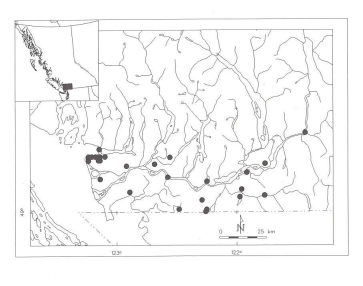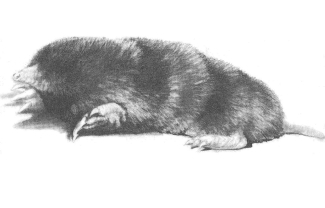In British Columbia, mating takes place from January to early March. Testes begin to enlarge in early January, and by May they have regressed in size. Females with embryos have been found from February to April; by May all females have given birth. The length of the gestation period is unknown. Females produce one litter a year and are capable of breeding in their first year. The average litter size is four, although females in their first year usually have only two young. Newborn young have not been observed, but presumably they are naked and lack teeth. Two young Coast Moles (13 and 15 grams) found in a nest were almost naked but had well-formed feet and tails.
|
Throughout its range, the Coast Mole feeds predominantly on earthworms. It also eats snails, slugs, millipedes, centipedes and various soil insects; shrew and mouse remains have been found in a few stomachs. In an analysis of the stomach contents of 108 Coast Moles trapped in British Columbia, 93 per cent contained earthworms, 2 per cent slugs, 3 per cent insects and 2 per cent unknown material. Captive Coast Moles avoided hairy caterpillars and dried or tainted earthworms. In captivity, this species can eat nearly twice its body weight in earthworms daily. Wild moles may not consume as much, but they must take extremely high numbers of earthworms. It has been estimated that a population of ten Coast Moles per hectare would eat some 219,000 earthworms per year.
Observations of caged moles suggest that this species hunts almost continuously, using its snout to locate prey by scent or touch. The mole removes soil from the prey with its front feet, then pulls the worm into its mouth, rapidly chewing and swallowing.
|
The Coast Mole constructs several types of tunnels. Hunting tunnels, appearing as surface runs or ridges on the soil, are made just below the surface of the ground. The mole simply pushes the dirt to the side so there are no mounds. Usually the tunnels are used only once for hunting, dispersal or searching for a mate during the breeding season. Most activity takes place in tunnels 7 to 20 centimetres below the surface. During dry spells, tunnels one to two metres deep may be constructed. Glendenning described a Coast Mole tunnel two metres below the surface in compact sand, found during the excavation of a well at Agassiz. Tunnels are about 4 centimetres in diameter, small enlarged chambers (10 x 8 cm) occur at various intervals, often at the ends of tunnels or the junction of several tunnels. Presumably they serve as rest or nest chambers.
Soil from tunnel excavation is deposited in mounds or molehills on the surface. The molehills are smaller than those of Townsend's Mole, averaging 30 centimetres in diameter and 11 centimetres high. Digging is most pronounced in autumn and winter when the soil is moist and easy for moles to work. This is the time of year when Coast Moles may expand their range into new areas. It has been estimated that between October and March one Coast Mole can construct as many as 400 molehills. During winter, molehills of the Coast Mole are very conspicuous in fields, lawns, pastures, golf courses and grassy borders adjacent to highways.
During the breeding season, females construct nursery nests for rearing their young. Nests are situated at shallow depths (15 centimetres below the ground) where they are heated by the sun. They are about 20 centimetres across and are lined with dried grass. Nests typically have several entrances that are interconnected with runways. Unlike Townsend's Mole, there are usually no large earth mounds associated with the nursery nests.
Several researchers have suggested that this species is primarily nocturnal. However, an individual marked with a radioactive tracer and tracked with a Geiger counter was active throughout a 24-hour period with activity rhythms of about 4 hours. Subterranean movements of this animal ranged from 2 to 30 metres. The home range of the Coast Mole averages about 0.12 hectares. Population estimates for the province range from less than one mole per hectare to as high as thirteen per hectare in ideal habitats. Population numbers correlate with the physical characteristics of soil and the numbers of earthworms.
Using tooth wear as an indicator of age, Valentin Schaefer estimated that Coast Moles live three to four years in the wild. Major predators are owls, such as the Barn Owl, which generally prey on juvenile moles when they leave the breeding nest and disperse above ground in summer. In Oregon, the Rubber Boa is a predator of nestling moles. Dogs and cats are also major predators, especially during the period of juvenile dispersal. Winter and spring flooding may have a detrimental effect on some populations. During a major flood of the Fraser River in 1948, Coast Moles were observed escaping from fields and swimming to high ground. Mole populations in the flooded areas declined, but this may have resulted more from the destruction of earthworms than the direct loss of moles from drowning.
|
|


